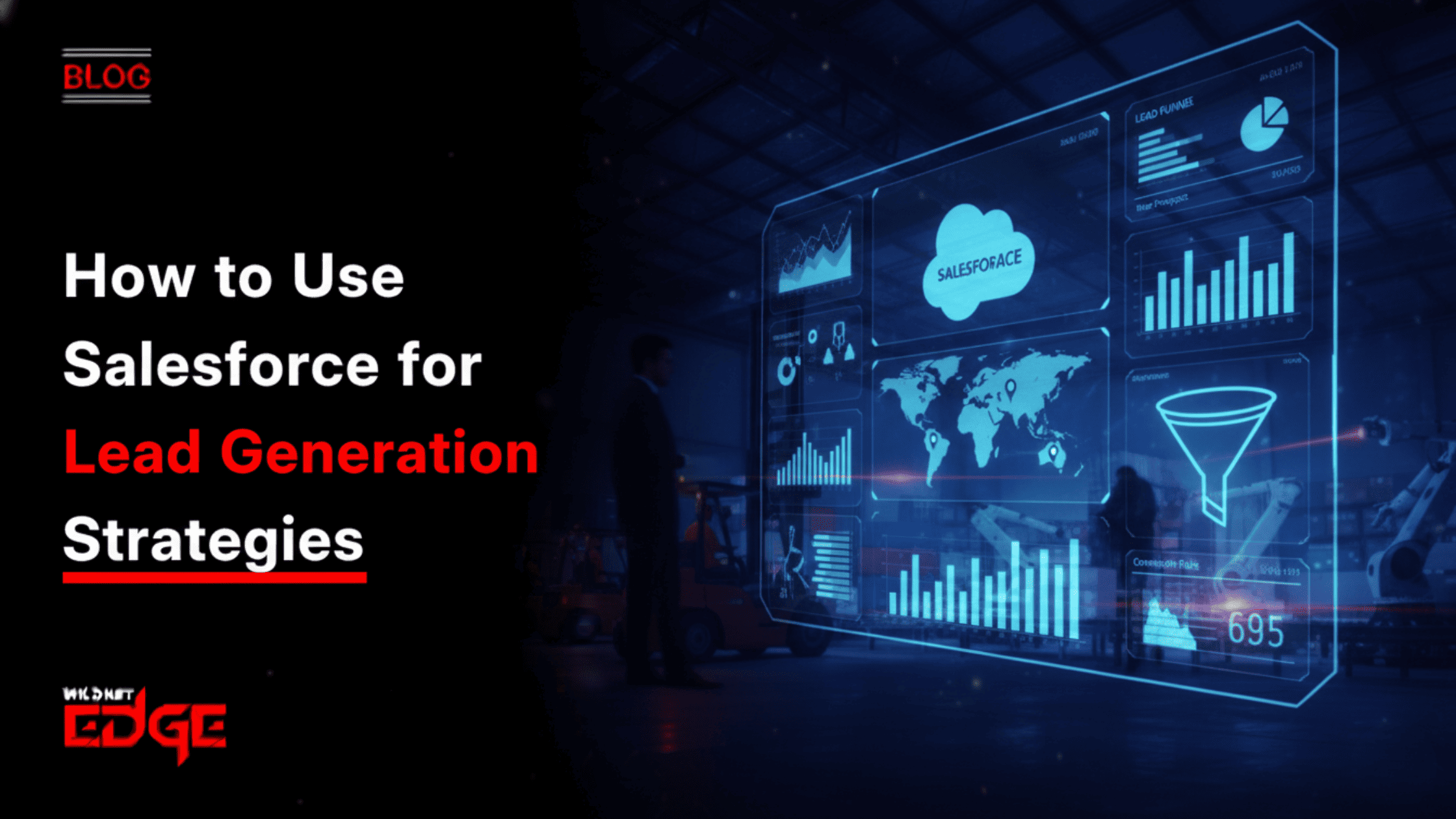TL;DR
This article outlines how Salesforce can be strategically utilised for effective lead generation, moving beyond basic contact storage to become a powerful engine for growth. It details how Salesforce facilitates capturing leads from various sources, such as web forms and marketing campaigns, ensuring no opportunity is missed. The blog emphasises the importance of robust CRM lead management, including lead scoring and automated nurturing workflows, to prioritise efforts and improve conversion rates. Furthermore, it explains how sales funnel automation within Salesforce streamlines the process from initial contact to qualified opportunity, enhancing overall efficiency. The piece concludes that mastering Salesforce lead generation is crucial for sustainable revenue growth.
Generating a consistent flow of high-quality leads is the lifeblood of any business. However, simply collecting names and email addresses is not enough. You need a system to capture, nurture, qualify, and convert those leads efficiently. This is where Salesforce, the world’s leading CRM platform, becomes an indispensable tool. Leveraging Salesforce lead generation capabilities is not just about managing contacts; it’s about building a scalable engine for sustainable business growth.
What is Salesforce Lead Generation?
Salesforce lead generation refers to the process of using the Salesforce platform to attract, capture, track, and qualify potential customers (leads) for your business. It involves utilizing Salesforce’s integrated tools and features to manage the entire lead lifecycle, from the first point of contact through to becoming a qualified sales opportunity.
Unlike standalone marketing tools or simple spreadsheets, Salesforce provides a centralized hub where your marketing and sales teams can collaborate. It ensures that every lead is captured accurately, routed to the right person, and nurtured effectively, maximizing your chances of conversion. This unified approach is essential for effective CRM lead management.
Why Salesforce is a Powerhouse for Lead Generation
Using a dedicated CRM like Salesforce offers significant advantages over disjointed or manual lead generation processes.
Centralized Lead Capture Across All Channels
Leads can come from anywhere: your website, social media, email campaigns, trade shows, or third-party lists. Salesforce provides tools to capture these leads directly into your CRM, regardless of the source. Features like Web-to-Lead forms automatically create a new lead record whenever someone fills out a form on your website. This ensures no potential customer slips through the cracks.
Intelligent Lead Nurturing and Qualification
Not all leads are created equal. Salesforce allows you to implement lead scoring models that automatically rank leads based on their demographics and engagement level. This helps your sales team prioritize their efforts on the hottest prospects. Furthermore, you can build automated nurturing campaigns using tools like Marketing Cloud Account Engagement (Pardot) to educate and engage leads over time, moving them through the sales funnel until they are ready for a sales conversation. This level of sales funnel automation is crucial for efficiency.
Seamless Handover from Marketing to Sales
One of the biggest friction points in lead generation is the handover between marketing and sales. Salesforce facilitates a smooth transition. Marketing can qualify leads based on agreed-upon criteria, and then automatically route them to the appropriate sales representative with full visibility into the lead’s history and interactions. This alignment ensures a consistent and informed experience for the prospect. Effective Salesforce Consulting can help optimise this critical workflow.
Key Salesforce Features for Lead Generation Strategies
Salesforce offers a suite of tools specifically designed to enhance your lead generation efforts.
- Web-to-Lead: Easily create forms for your website that automatically capture lead information directly into Salesforce.
- Campaign Management: Track the effectiveness of your marketing campaigns (e.g., email blasts, webinars, ad campaigns) by linking them directly to the leads they generate. This allows you to measure ROI accurately.
- Lead Scoring & Grading: Define rules to automatically score leads based on their profile (grading) and engagement (scoring) to prioritise follow-up.
- Lead Assignment Rules: Automatically route incoming leads to the correct sales rep or queue based on criteria like territory, industry, or lead source.
- Marketing Automation: Build sophisticated email nurturing campaigns, track prospect activity on your website, and create dynamic landing pages to capture more leads. This is key to effective sales funnel automation.
Our Salesforce Lead Generation Services in Action: Case Studies
Case Study 1: A B2B Tech Company’s Inbound Lead Surge
- The Challenge: A software company was generating website traffic but struggled to convert visitors into qualified leads. Their manual process for handling contact form submissions was slow and inefficient.
- Our Solution: We implemented Salesforce Web-to-Lead forms across their website and configured automated lead assignment rules. We also set up a simple lead scoring model and an automated email nurturing sequence using Pardot for leads who weren’t yet sales-ready. This required a strategic Salesforce Implementation.
- The Result: The company saw a 40% increase in qualified leads captured through their website. Lead response time dropped from over 24 hours to under 15 minutes, significantly improving their initial engagement with prospects.
Case Study 2: A Financial Services Firm’s Campaign Tracking
- The Challenge: A financial advisory firm was running multiple marketing campaigns across different channels but had no clear way to track which campaigns were actually generating valuable leads and customers.
- Our Solution: We leveraged Salesforce Campaign Management features. We ensured every lead source was accurately tracked and built custom reports and dashboards to visualize campaign performance, ROI, and influence on closed deals. This required careful planning and Salesforce Integration with their marketing tools.
- The Result: The firm gained clear visibility into their marketing ROI. They were able to reallocate their budget away from underperforming campaigns and double down on the channels that delivered the most valuable leads, resulting in a 25% increase in overall lead quality.
Our Technology and Expertise
We are experts in leveraging the Salesforce platform for effective CRM lead management.
- Core Platforms: Sales Cloud, Marketing Cloud Account Engagement (Pardot)
- Automation Tools: Flow, Process Builder, Apex
- Lead Capture: Web-to-Lead, Email-to-Lead, AppExchange Integrations
- Analytics: Salesforce Reports & Dashboards, Tableau
Conclusion
Mastering Salesforce lead generation is fundamental to achieving scalable and predictable revenue growth. By moving beyond basic contact management and embracing the platform’s powerful automation and analytics capabilities, you can build a highly efficient lead generation engine. Effective CRM lead management and sales funnel automation ensure that no opportunity is missed and that your sales team is always focused on the most promising prospects.
Ready to supercharge your lead generation efforts? At Wildnet Edge, our AI-first approach enhances our Salesforce Development Services, allowing us to build intelligent lead scoring models and automate processes in ways that provide a significant competitive advantage. Connect with us to transform your lead flow.
FAQs
Salesforce offers multiple features for this. Lead Assignment Rules instantly route new leads to the right person. Automated alerts can notify reps immediately. Furthermore, you can build Flows that automatically create follow-up tasks or send initial emails, ensuring no lead sits idle.
Lead Grading measures how closely a lead matches your ideal customer profile (ICP) based on explicit data like company size, industry, or job title (e.g., Grade A, B, C). Lead Scoring measures a lead’s engagement level based on their actions, like website visits or email clicks (e.g., a score from 1-100). Both are key components of effective CRM lead management.
Yes, Salesforce offers integrations that allow you to capture leads directly from social media platforms, including LinkedIn Lead Gen Forms. This ensures leads generated from your social campaigns flow seamlessly into your CRM.
While Sales Cloud offers basic email capabilities, dedicated marketing automation tools like Marketing Cloud Account Engagement (Pardot) or Marketing Cloud provide much more sophisticated features for building complex nurturing journeys, tracking prospect activity, and scoring leads based on engagement. They are highly recommended for serious sales funnel automation.
Salesforce’s Campaign Management functionality is designed for this. By associating every lead with its source campaign, e.g., “Spring Webinar,” “Google Ads Q3”, you can run reports to see which campaigns generate the most leads, opportunities, and ultimately, closed-won revenue, providing clear ROI data.
Salesforce has built-in duplicate management rules that you can configure to identify and merge potential duplicate leads based on criteria like email address or company name. Keeping your data clean is crucial for accurate reporting and effective communication.
Salesforce provides the data visibility needed to understand what defines a high-quality lead for your specific business. By analyzing the characteristics and behaviours of leads that ultimately become customers, you can refine your marketing targeting and lead scoring criteria to focus on attracting more prospects like them, enhancing your Salesforce lead generation effectiveness.

Nitin Agarwal is a veteran in custom software development. He is fascinated by how software can turn ideas into real-world solutions. With extensive experience designing scalable and efficient systems, he focuses on creating software that delivers tangible results. Nitin enjoys exploring emerging technologies, taking on challenging projects, and mentoring teams to bring ideas to life. He believes that good software is not just about code; it’s about understanding problems and creating value for users. For him, great software combines thoughtful design, clever engineering, and a clear understanding of the problems it’s meant to solve.
 sales@wildnetedge.com
sales@wildnetedge.com +1 (212) 901 8616
+1 (212) 901 8616 +1 (437) 225-7733
+1 (437) 225-7733































